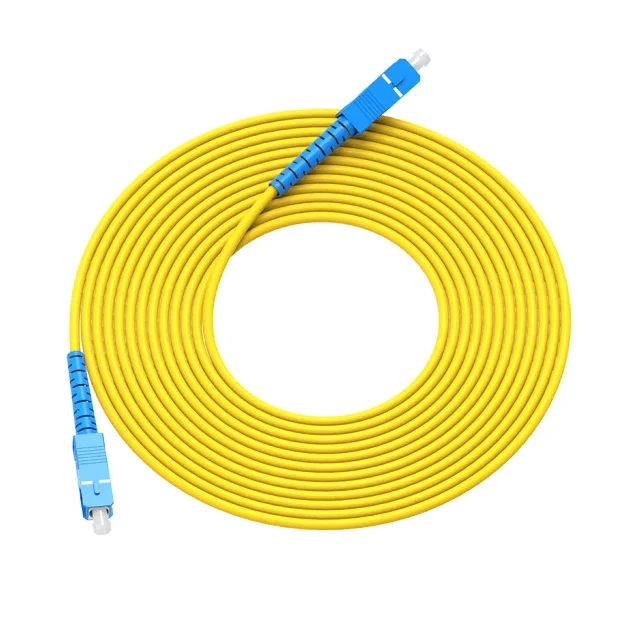- This topic is empty.
-
AuthorPosts
-
July 1, 2024 at 4:07 pm #108684
In today's information and digital age, fiber optic communication has become an important way of data transmission. In building an efficient and stable fiber optic communication system, choosing the right fiber jumpers is a crucial link. The quality, type, and applicability of fiber jumpers are directly related to the performance and stability of the communication system. So, how to choose the fiber jumpers that best suit your needs among these many options? This article will discuss in detail the key factors to consider when choosing fiber jumpers.
1. Determine the needs
First, you need to determine whether your system uses single-mode fiber or multimode fiber. The most essential difference between the two is in the transmission mode of light. Single-mode fiber has a very small core (about 9 to 10 microns in diameter) and only allows one mode of light to pass through. It is suitable for long-distance transmission and can provide high-speed and large-capacity data transmission. Multimode fiber has a wider core, usually 50 or 62.5 microns, and can transmit multiple modes of light at the same time, but is suitable for shorter transmission distances, such as connections within a local area network or data center.
2. Choice of interface type
Fiber jumpers have various interface types, including FC, SC, ST, LC, etc. Each type of connector has its own specific structure and connection method, so the interface type on the device side should be considered when choosing. For example, the LC connector is small and suitable for high-density applications; while the SC connector is more traditional and has better control of insertion loss and return loss. Choosing the right interface type can ensure the compatibility of fiber jumpers and the stability of the connection.
3. Environmental requirements
Different use environments have different requirements for fiber jumpers. For example, outdoor environments may require fiber jumpers to have good weather resistance; in high-temperature or chemically corrosive environments, fiber jumpers need to have special protective materials. In addition, fire resistance is also an important consideration, especially in commercial buildings and data centers.

4. Consideration of physical properties
The physical properties of fiber jumpers, such as bending radius, tension, temperature range, etc., are also very important. When the optical fiber is excessively bent, the loss will increase or even be damaged, so the degree of bending of the actual installation path should be considered when choosing. In addition, high-quality fiber jumpers should be able to withstand a certain amount of tension without breaking to ensure long-term stable operation.
5. Quality and Standards
The quality of fiber jumpers directly affects the stability and rate of signal transmission. When choosing, you should pay attention to whether it meets international standards, such as ISO, IEC, TIA, etc. High-quality fiber jumpers will have low insertion loss and low return loss, which optimizes the transmission performance. You can understand these parameters through the product test report.
6. Price and Budget
On the premise of meeting technical requirements, price is also a factor that cannot be ignored. The choice should be made based on the actual budget and performance requirements.
7. Supplier Reliability
It is equally important to choose a reliable fiber jumper supplier. A good supplier can not only provide high-quality products but also provide good after-sales service. When choosing a supplier, you can consider factors such as its market reputation, technical support capabilities, and after-sales service commitments.
8. Additional functions
Some fiber jumpers also have additional functions, such as tensile strength enhancement, armored type, etc., to meet the needs of special environments. If the system is located in a complex environment, you can consider choosing these jumpers with additional protection functions.
9. Jumper length
Although the length of fiber jumpers can be customized, not all lengths are suitable for all types of jumpers. Some types of jumpers, such as multimode fiber jumpers, may produce greater signal loss at too long a distance. Therefore, when choosing the jumper length, it is necessary to make reasonable calculations based on the actual application environment and jumper type.
10. Certification and compliance
For specific industries, it is necessary to select fiber jumpers that meet industry standards and certification requirements. For example, in the medical, military, or aviation industries, fiber optic equipment needs to meet more stringent standards. Ensuring that the selected fiber jumpers have passed the necessary certifications can avoid compliance issues that may occur in the future.
Selecting the right fiber jumpers involves not only comprehensive consideration of the above factors but also forward-looking planning for system architecture, future scalability, and compatibility. The right choice can maximize the performance of the communication system, reduce future maintenance costs, and ensure the long-term stable operation of the system.
-
AuthorPosts
- You must be logged in to reply to this topic.